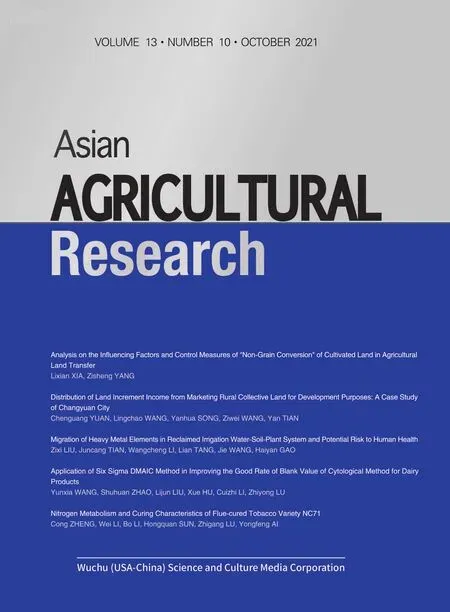Study on Phthalate Esters Pollution in the Soil of Facility Vegetable Base in Yangling District of Xianyang City
2021-12-31GuoxiuLILihuiCUIWeiLIUXiaoningLIU
Guoxiu LI, Lihui CUI, Wei LIU, Xiaoning LIU
Department of Biological Engineering, Yangling Vocational & Technical College, Yangling 712100, China
Abstract [Objectives] To evaluate the pollution status of phthalate esters (PAEs) in the soil of facility vegetable base in Yangling District of Xianyang City. [Methods] A total of 15 kinds of PAEs in soil samples were detected and analyzed by gas chromatography-mass spectrometry. [Results] A total of 12 kinds of PAEs were detected in analyzed soil samples, with a total content of 53.4-3 524.1 μg/kg and an average of 602.7 μg/kg. Specifically, DEHP, DBP, DIBP, DMEP, BBP and DNOP were the main PAEs pollutants in the soil, with the detection rates of 100%, 100%, 100%, 73.3%, 63.3% and 53.3%, and the average content were 286.3, 167.3, 123.1, 157.6, 121.3, and 130.5 μg/kg, respectively. [Conclusions] Compared with the soil in other regions, the pollution level of PAEs in the soil of facility vegetable base in Yangling District is lower, but such compounds are widespread in the facility vegetable base, and their potential environmental risks should attract close attention.
Key words Phthalate esters (PAEs), Vegetable base, Soil, Pollution status
1 Introduction
Phthalate esters (PAEs) are synthetic organic compounds with large production volume and wide range applications in the world. As plasticizers, PAEs are widely used in PVC plastic products. Also, they are widely used in pesticide carriers such as insect repellents and insecticides, as well as additives in cosmetics, synthetic rubber, lubricants, foils, and printing inks. PAEs are easily soluble in organic reagents and lipids, but hardly soluble in water. Due to the stability and persistence in the environment, PAEs usually have bioaccumulation effect and amplification effect, which can enter the food chain and endanger human health and safety. Studies have shown that some kinds of PAEs have endocrine disrupting, carcinogenic, teratogenic and mutagenic effects. Soil is an important medium for the accumulation and migration of PAEs. Agricultural film residue, use of organic fertilizer, sewage irrigation, and use of sludge as fertilizer are the main sources of PAEs in farmland soil. As people pay more and more attention to the quality and safety of agricultural products, the pollution of PAEs in farmland soil has also attracted people’s attention. Researchers at home and abroad have conducted extensive studies on the PAEs pollution level in regional soil. Due to the differences in planting methods, soil types, climate conditions and industrial development, the PAEs pollution levels and characteristics of farmland soil vary among different regions. Li Binet
al.
compared PAEs in soils of different planting types and found that the pollution degree successively was vegetable field>orchard field>paddy field. Plants can absorb PAEs pollutants from the soil through root system and eventually enter the human body through the food chain, threatening human health. Therefore, soil pollution in vegetable bases is closely related to the quality and safety of vegetables. Hence, it is of great practical significance to study the PAEs pollution in vegetable base soil. In order to understand the pollution status of PAEs in vegetable base soil of Yangling District, 15 kinds of PAEs in the soil of local typical facility vegetable base were detected by gas chromatography-mass spectrometry in this study, in order to provide basic data for agricultural soil quality control and risk prevention and control of quality and safety of agricultural products.2 Materials and methods
2.1 Materials
2.1.1
Instruments. The instruments used in the study included GCMS-QP2010Plus gas chromatography-mass spectrometry (Shimadzu Corporation, Japan), OSJ-UP-V ultrapure water machine (Shandong Biobase Scientific Instrument Co., Ltd.), RE-52C rotary evaporator (Zhengzhou Yarong Instrument Co., Ltd.), water bath constant temperature oscillator (Shanghai Qiqian Electronic Technology Co. Ltd.), MD-200 termovap sample concentrator (Hangzhou Allsheng Instruments Co., Ltd.), and Mixplus vortex mixers (Hefei Abson Scientific Instrument Co., Ltd.).2.1.2
Reagents. A total of 15 kinds of PAEs organic mixture standard samples (Tanmo Quality Inspection Standard Material Center) with the concentration of 1 000 μg/mL were used in the test, including dimethyl phthalate (DMP), diethyl phthalate (DEP), diisobutyl phthalate (DIBP), dibutyl phthalate (DBP), bis (2-methoxyethyl) phthalate (DMEP), bis (4-methyl-2-pentyl) phthalate (BMPP), bis(2-ethoxyethyl) phthalate (DEEP), dipentyl phthalate (DPP), dihexylphthalate (DHXP), benzyl butyl phthalate (BBP), bis(2-butoxyethyl)phthalate (DBEP), dicyclohexyl phthalate (DCHP), bis (2-ethylhexyl) phthalate (DEHP), Di-n-octylo-phthalate (DNOP), dinonyl phthalate (DNP). Acetone, n-hexane, acetonitrile, dichloromethane and methanol were chromatographically pure. The solid-phase extraction column was a PSA/Silica composite packed glass column (1 000 mg, 6 mL).2.2 Methods
2.2.1
Collection and preparation of soil samples. Yangling District, under the jurisdiction of Xianyang City, Shaanxi Province, is located in the central Guanzhong Plain, which is a state-level agricultural high-tech industry demonstration zone. In this study, 10 typical facility vegetable bases in Yangling District and its surrounding areas were selected. Using multi-point sampling and mixing method, 6-8 points were collected from each greenhouse vegetable plot to form a soil mixture sample, avoiding the edge of vegetable plot, crop roots and newly fertilized sites. Accurately 1 kg of soil was put into a cloth bag following quartering method. As the sundries and plant residues were removed, the soil samples were spread on the air-drying tray with the thickness of 2-3 cm, and put in ventilated and cool place for natural air-drying. After grinding, the samples were passed through 60 mesh sieve, collected in brown glass bottles and stored in the refrigerator for later testing.2.2.2
Sample pretreatment. Samples were pretreated referred to national standard GB 5009.271-2016and the method proposed by Wang Xiaoyanet
al.
. Approximately 10.0 g of soil samples were placed in a 150 mL conical flask, added with 30 mL of acetone and n-hexane mixture (volume ratio 1∶2). The mixture was extracted by shaking at 180 r/min for 20 min. After left undisturbed for 10 min, the supernatant was filtered into a 100 mL round-bottom flask, and evaporated to nearly dry at 40 ℃. Afterwards, 5.0 mL of acetonitrile was added to redissolve, which would be further purified.The extraction solution was purified by solid phase extraction (SPE) with PSA/Silica composite packed glass column (1 000 mg, 6 mL). The purification column was first activated with 5.0 mL of dichloromethane and 5.0 mL of acetonitrile successively, and the effluent was discarded. Then, 1.0 mL of liquid to be purified was added to the purification column, and 5.0 mL of acetonitrile was immediately added to elute when the liquid level was near the packing layer to collect the eluent. The eluent was blown to nearly dry by nitrogen at 40 ℃, and set to the fixed volume of 2 mL with n-hexane. After mixed by vortex, the solution was used for GC-MS analysis.
2.2.3
Sample analysis. The samples were analyzed by GC-MS. The chromatographic conditions were as follows: DB-5 MS quartz capillary column (30 mm×0.25 mm, 0.25 μm); carrier gas high purity helium (purity>99.999%), carrier gas flow 1.0 mL/min; splitless injection, injection volume 1.0 μL; injector temperature 280 ℃. The column temperature was programmed: initial column temperature 60 ℃ and retained for 1 min; raised to 220 ℃ at 8 ℃/min and retained for 4 min; heated to 270 ℃ at 15 ℃/min; raised to 300 ℃ at 5 ℃/min and retained for 15 min. The mass spectrometry conditions were as follows: electron impact ionization source (EI); ionizing energy 70 eV; transmission line temperature 280 ℃; ion source temperature 230 ℃; selected ion monitoring (SIM). The monitoring ions are shown in Table 1. The ion current of 15 kinds of PAEs is presented in Fig.1. Fifteen kinds of PAEs were added to the soil to monitor the recovery rate, and the recovery rates ranged from 74% to 106%, which met the test standard requirements. Standard solutions of 15 kinds of PAEs were diluted with n-hexane step by step to prepare standard series solutions with concentrations of 0.01, 0.02, 0.05, 0.10, 0.50 and 1.00 μg/mL, respectively. The working curve was drawn and the solutions were quantified by external standard method.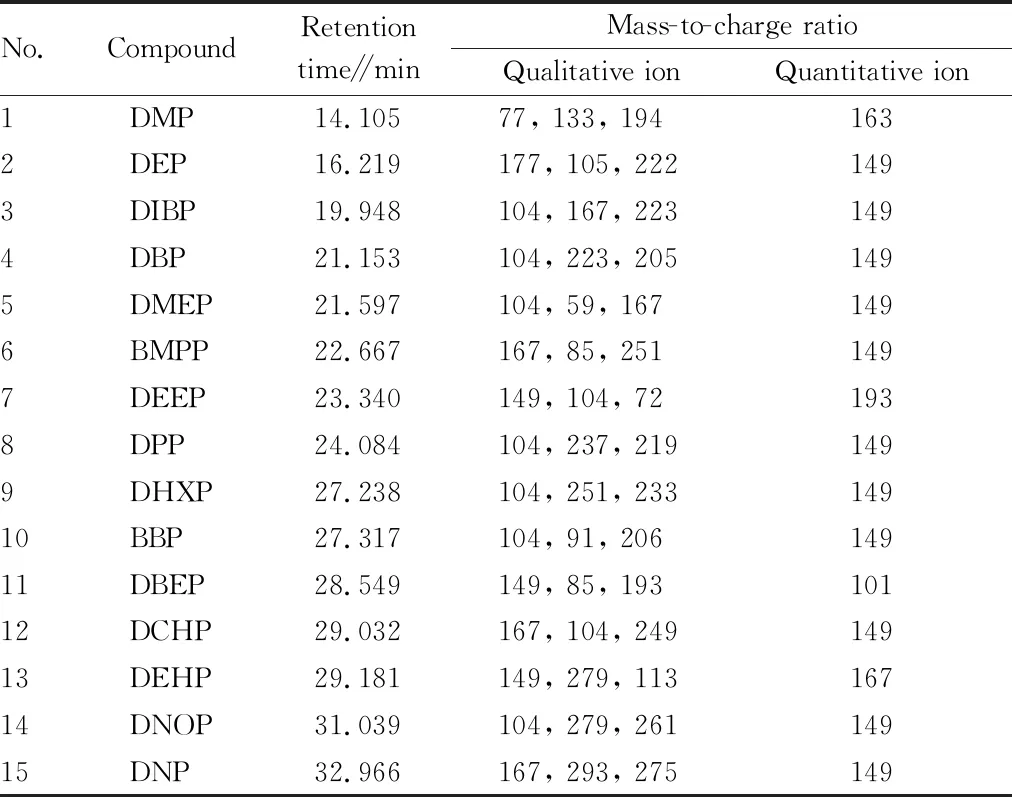
Table 1 Retention time and monitoring ions of 15 kinds of PAEs
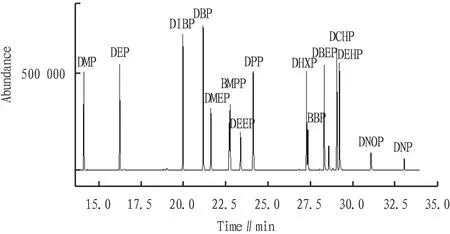
Fig.1 Ion current of 15 kinds of PAEs
3 Results and analysis
3.1 Total contamination level of PAEs in the soil
The pollution levels of 15 kinds of PAEs in the soil collected from 30 greenhouses in 10 vegetable bases were analyzed. PAEs could be detected from all soil samples, and the analysis results are shown in Table 2. The total content of 15 kinds of PAEs in soil ranged from 53.4 to 3 524.1 μg/kg, with an average of 602.7 μg/kg and a median of 191.4 μg/kg. The total concentrations of 6 kinds of PAEs (DMP, DEP, DBP, BBP, DEHP and DNOP) recommended for priority control by US EPA ranged from 32.3 to 859.4 μg/kg, with an average of 336.7 μg/kg and a median of 98.3 μg/kg, and the detection rate was 100%. The result indicated that PAEs were common pollutants in the soil of vegetable base, which was consistent with the survey results of Niuet
al.
. Soil pollution levels of PAEs varied among different producing areas. Chaiet
al.
showed that the total concentration of PAEs in the soil of greenhouse vegetables in Shandong Province was about 1.94-35.40 mg/kg. Yanget
al.
measured the content of PAEs in agricultural soil samples in typical regions of Guangdong Province, and found that the content of 6 kinds of ΣPAEs in paddy fields listed in the soil control standards of the United States was ND-25.99 mg/kg. Zhaoet
al.
investigated the surface soil of vegetable gardens and orchards in typical small and medium-sized cities in the Pearl River Delta urban agglomeration, and found that the content of 6 kinds of ΣPAEs listed in the control standard of the United States reached 3.7 mg/kg in the soil of Dongguan City. The total concentrations of PAEs detected in this study and the concentrations of 6 kinds of PAEs in soil control standards of the United States were lower than those reported in the above study. Therefore, the content of PAEs in the soil of Yangling facility vegetable base was still at a low pollution level.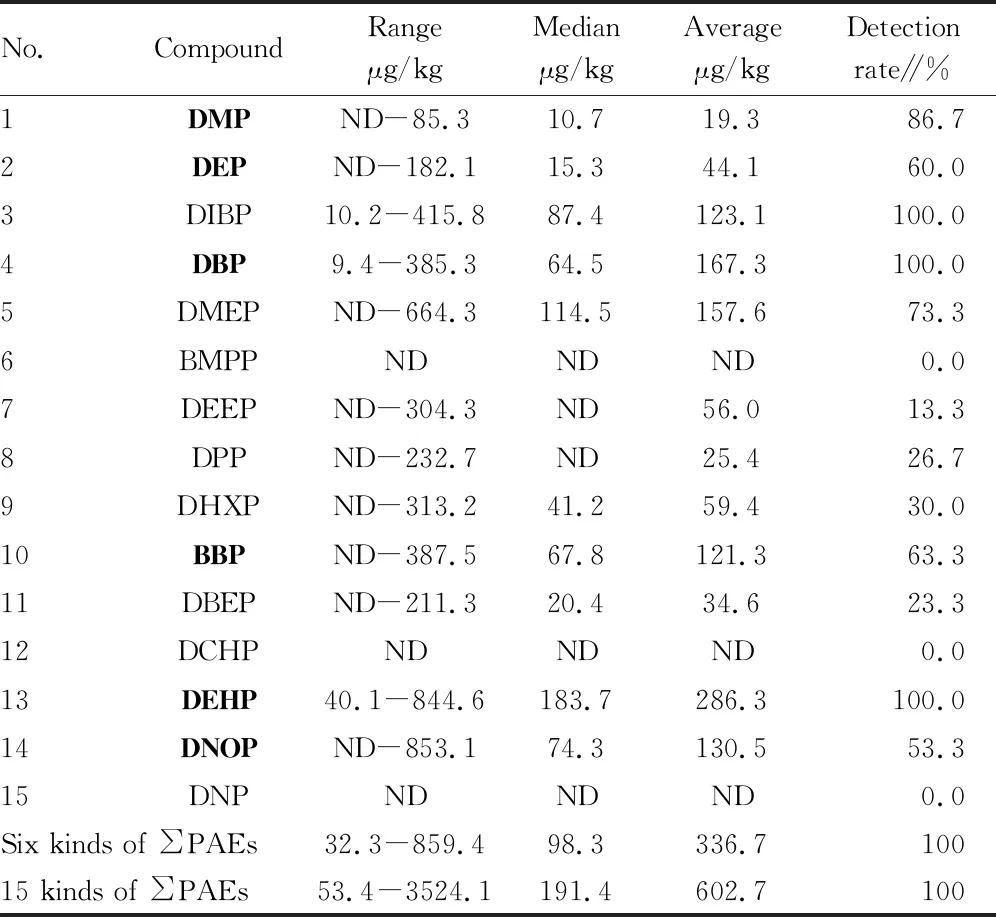
Table 2 Content and detection rate of 15 kinds of PAEs in soil samples
3.2 Content characteristics of PAEs monomer in soil
A total of 12 kinds of PAEs were detected in soil samples; DIBP, DBP and DEHP had the highest detection rate of 100%, followed by DMP, DMEP, BBP, DEP, DNOP, DHXP, DPP, DBEP and DEEP, with the detection rates of 86.7%, 73.3%, 63.3%, 60.0%, 53.3%, 30.0%, 26.7%, 23.3%, 13.3%, respectively; BMPP, DCHP and DNP were not detected under the detection conditions. As shown in Fig.2, the content of DEHP was the highest, and its content ranged from 40.1 to 844.6 μg/kg, with an average content of 286.3 μg/kg; the content of DBP ranged from 9.4 to 385.3 μg/kg, with an average of 167.3 μg/kg; the average contents of DMEP, DNOP, DIBP and BBP were 157.6, 130.5, 123.1 and 121.3 μg/kg, respectively; the contents of DHXP, DEEP, DEP, DBEP, DPP and DMP were all lower than 100 μg/kg. According to the analysis data, the average content and detection rate of DEHP and DBP were higher; the average content and detection rate of DMEP, BBP and DNOP were medium; the average DIBP content was medium, but the detection rate was high; the detection rate of DMP and DEP was high, but the average content was low; the average content and detection rate of DHXP, DEEP, DBEP and DPP were all low. Therefore, DEHP, DBP, DIBP, DMEP, BBP and DNOP were the main PAEs pollutants in the soil.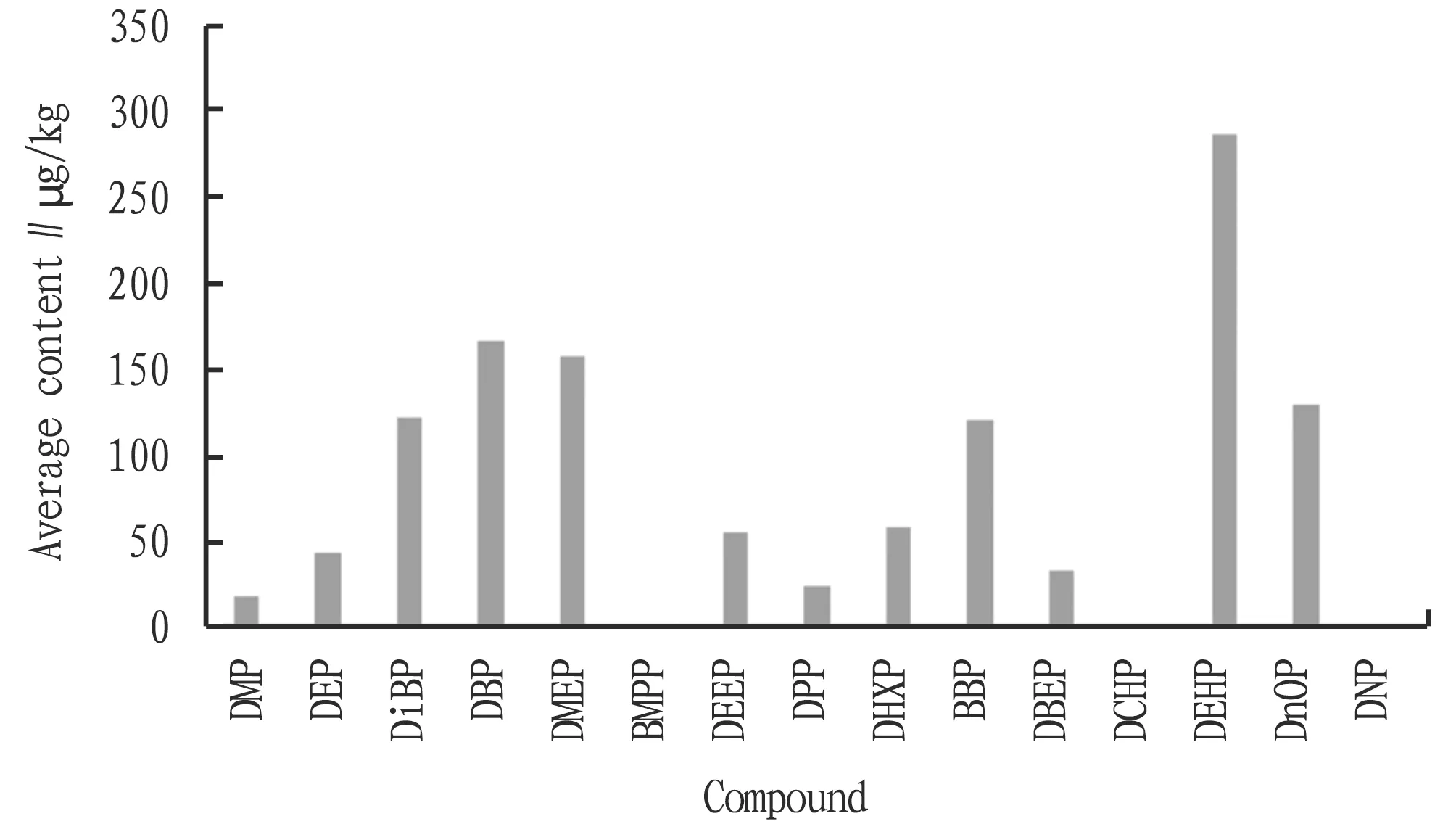
Fig.2 Average content of 15 kinds of PAEs in soil samples
PAEs in the agricultural environment mainly come from large use of plastic mulch and chemical fertilizer, agricultural use of sewage and sludge, and pesticide application. Previous studies have shown that short-chain PAEs such as DEP and DMP in soil have high water solubility and are easily degraded, and their content in soil can be reduced through volatilization, leaching, biotic or abiotic degradation and plant absorption; but long-chain compounds in PAEs, such as DEHP and DBP, belonging to high polymer compounds, have poor water solubility and are easy to be absorbed by soil, and it is difficult to disappear through biodegradation pathways in the soil. Therefore, the content of DEHP and DBP in the soil is often higher.
3.3 The exceeding standard status of PAEs in the soil
Currently, there is no relevant standard for soil PAEs pollution in China, and the PAEs control and treatment standard in soil formulated by the State of New York is often adopted for PAEs control, as shown in Table 3. For the 6 kinds of PAEs recommended for priority control by US EPA, all of them were detected in this study area. The average content of DMP did not exceed the control standard, but the content of three samples exceeded the control standard, with the exceeding standard rate of 10%. The average content of DEP did not exceed the control standard, but the content of two samples exceeded the control standard, with the exceeding standard rate of 7%. The average content of DBP exceeded the control standard, and the exceeding standard rate was 50%. BBP, DEHP and DNOP in the samples did not exceed the control standard. The content of PAEs monomer in all samples did not exceed the soil treatment standard.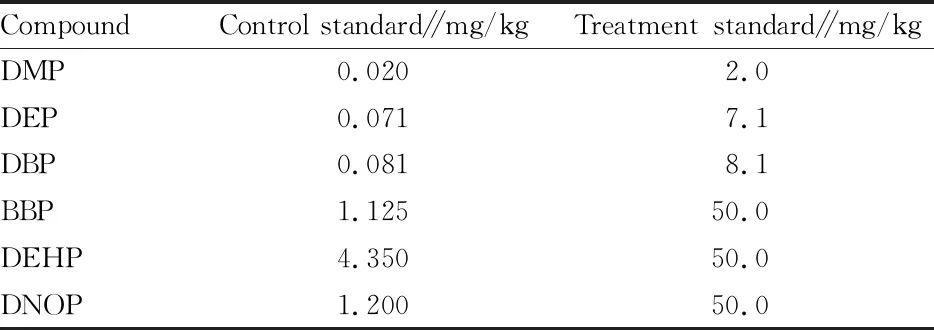
Table 3 Control standard and treatment standard of soil PAEs of the United States
4 Conclusions
In this study, 12 kinds of PAEs were detected in the soil of facility vegetable base, and the total content was 53.4-3 524.1 μg/kg, with an average of 602.7 μg/kg and a median of 191.4 μg/kg. Compared with other areas, the PAEs pollution level in vegetable base soil of Yangling District was at a lower level. Specifically, DEHP, DBP, DIBP, DMEP, BBP and DNOP were the main PAEs pollutants in the soil, with the detection rates of 100%, 100%, 100%, 73.3%, 63.3% and 53.3%, and their average contents were 286.3, 167.3, 123.1, 157.6, 121.3 and 130.5 μg/kg, respectively. Among the 6 kinds of PAEs recommended for priority control by US EPA, the average content of only one PAEs monomer, DBP, exceeded the control standard, with the exceeding standard rate of 50%, while the average content of other PAEs monomers did not exceed the control standard. DMP and DEP exceeded the control standard in small number of soil samples, and the exceeding standard rates were 10% and 7%, respectively. The content of PAEs monomer in all samples did not exceed the soil treatment standard.
The results suggest that PAEs are ubiquitous in vegetable soil in this study area, and the pollution degree varies among various PAEs monomers. It is not clear whether PAEs compounds will be enriched in vegetables and whether they will affect the quality and safety of vegetables. The impact of soil pollution PAEs on the quality and safety of vegetables and assessment of health risks of PAEs in vegetables to human body will be the focus of future research.
杂志排行
Asian Agricultural Research的其它文章
- Nitrogen Metabolism and Curing Characteristics of Flue-cured Tobacco Variety NC71
- Distribution of Land Increment Income from Marketing Rural Collective Land for Development Purposes: A Case Study of Changyuan City
- Research on the Balance of Urban Benchmark Land Price in Henan Province: A Case Study of Commercial Land
- Enlightenment of EU New Common Agricultural Policy on Protection and Sustainable Utilization of Cultivated Land in China
- Effects of Nitrogen Forms on the Growth and Development of Trees
- Migration of Heavy Metal Elements in Reclaimed Irrigation Water-Soil-Plant System and Potential Risk to Human Health
